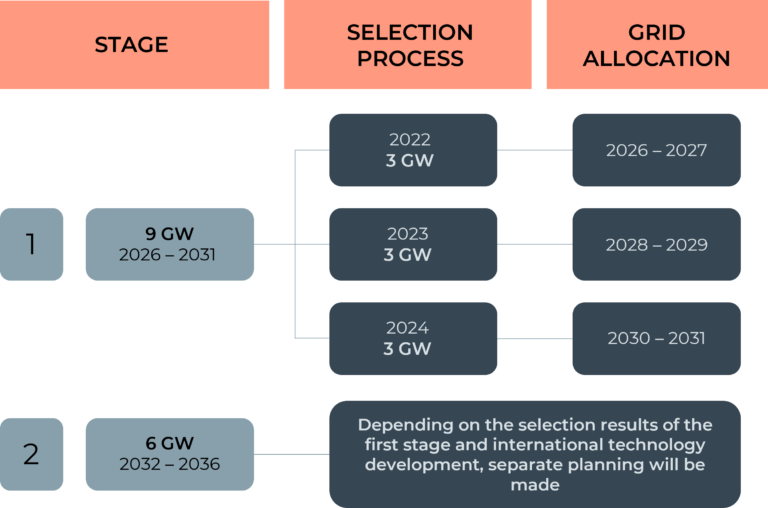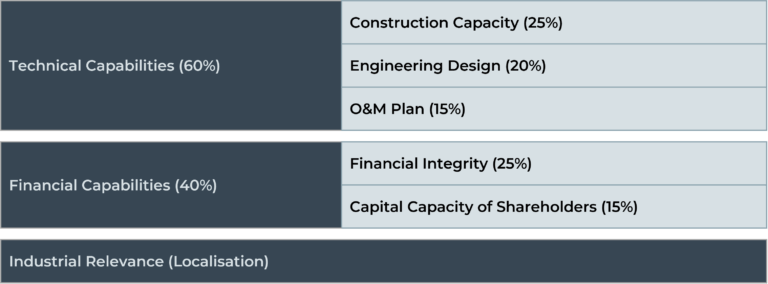Taiwan Today: What is Round Three Auction?
Taiwan has completed 5.5 GW of offshore wind tenders and it will, by 2025, have installed over 5.7 GWs on the west coast. This is the result of the government’s Thousand Wind Turbines Project presented in 2012, in which the government announced 3 phases to achieve their renewable energy targets. The Round Three is the last phase of that governmental project.
In this new round, the developers can bid for a total of 15 GW grid allocation in two stages:

The wind allocation plan for this round was published over the summer, 2021 and the long time waited final localization requirements for the 2022 selection process were finally released in December 2021. Nevertheless, the localisation rules were sufficiently clear before the final publication and the various developers have been working hard for a while, to get their strategies in place.
What are the Rules and Regulations? How will the Round Three Auction be Awarded? And What is on Everyone’s Minds: the Local Content Requirements
The rules for the first 9 GWs are summarized in the following publications:
Directions of Application for Offshore Wind Zonal Development:
It was published by the Ministry of Economic Affairs (MOEA) on 23 July 2021 and it, mainly, specifies the qualifications, the rules of site selection, and the required documents for application for the “Site Planning Recordation”.
- The developers can select sites themselves, but a number of “sensitive” areas announced by the authorities need to be avoided. This way it is up to the developers to compete for the best locations and to decide which technologies to deploy.
- MOEA has established a joint review mechanism across the ministries, to effectively streamline the administrative procedures to assist the developers in speeding up their preparatory work.
After confirmation of compliance with the regulations of various ministries, the applications will be reviewed and forwarded to the Environmental Protection Administration (EPA) for Environmental Impact Assessment (EIA) which then can focus on environmental and ecological issues only.
Process:
To participate in Round Three, the developers shall submit:
Stage 1. Proof of funds equivalent to at least 5% of the total proposed investment amount
Stage 2. The application for Site Planning Recordation to BOE
The goal is to provide BOE with a general picture at a very preliminary stage before EPA requests BOEs opinion in the EIA process.
- The application shall be no less than 100MW and 5MW/km2;
- The proposed sites shall not overlap with the existing windfarms, and it shall avoid the sensitive areas announced;
- The circular area occupied by the wind turbines rotating 360 degrees against the wind and yaw their vertical projection on the ground cannot exceed the intended OWF project site.
Once the application has passed the review process, it will receive an “unconditional no objections letter” (the Site Planning Recordation). Only then, the project application will be transferred to the Environmental Protection Administration (EPA) for the Environmental Impact Assessment (EIA) review (In practice, because the guidelines where not finalized until July 2021, many developers sent the Environmental Impact Statement for assessment before).
Environmental Impact Assessment (EIA) review: The EPA is to approve the EIA before progressing with the development of the project.
Basically, the developer issues an Environmental Impact Statement to the MOEA who will then provide it to the EPA who evaluates if there are any adverse environmental or ecological impacts.
Only the developers that have successfully obtained the Site Planning Recordation and have obtained a conditional approval of the EIA from EPA, can participate in the grid capacity allocation process which has been defined in the below publication.
Directions of Grid Capacity Allocation for Offshore Wind Energy Zonal Development and Localisation Policy for the 2022 Selection Process:
They were published by the Ministry of Economic Affairs (MOEA) on 19 August 2021 and December 2021 respectively.
The first not only confirms and sets the basis of the 15 GW release for this Round 3, but it also outlines the regulations and rules for an applicant to apply for grid capacity from BOE. The second sets the localization requirements for the 2022 selection process.
Some peculiarities compared to Round Two are:
- BOE has introduced a capacity allocation cap per developer, to encourage diversified participation: The maximum capacity that may be awarded to each project and to a single developer cannot exceed 600 MW (500 MW with a possibility of a 100 MW increase, under certain conditions).
- All developers must complete a two-stage process, in which they are first approved for technical competence, financial soundness and their level of localisation before being allowed to bid against each other.
- A “Maximum Bid Price” is set
- The localization requirements are more flexible, freeing the developers from 40% localisation obligations in relation to the technologies that are most difficult to localise (like nacelles for example). While this could be seen as a relaxed approach compared to Round Two, the list of items that must be locally sourced is in fact longer and will require a lot of ingenuity and creativity from both the developers and the supply chain.
Process:
The bidding process is divided in two steps:
Stage 1. Capability Review

The minimum score in order to be able to move to the next phase is:
- Average of 70 points in technical and financial capabilities
- Localisation of at least 60% of the items listed as “Key Development” and scoring more than 10 points on a number of “bonus items”.
Stage 2. Bidding Process (Price comparison)
The developer proposing the lowest price will have priority. In the event of a tie between bidders, the award will be made based on their level of proposed local content commitment.
The upper limit for the bidding price for the first tender in 2022 is set at NTD 2,49/Kwh and the floor price is NTD 0/Kwh.
For subsequent rounds, the capacity-weighted average of all bids received in the previous round will be used as the price ceiling and the lower limit will remain at NT$0/kWh.
The first selection process for the first 3 GWs will take place in August 2022 and we will all await the result closely after.
